
Nikon Z8 field report by Marsel van Oosten (website | facebook | twitter | instagram | flickr | 500px | previous guest posts on NR):
Introduction
Last month, I spent two weeks on the frozen sea ice along the coast of Baffin Island, Canada, searching for female polar bears who had just emerged from their dens with their newborn cubs. Knowing that encounters would likely not be closer than 100 meters, I decided the new Nikkor Z 600/4.0 TC VR S would be the perfect lens for this project. Luckily, Nikon was able to provide me with one, and they gave me the new Nikkor Z 400/4.5 VR S lens to try out — the smallest and lightest 400mm prime in its class.
When I arrived at Nikon HQ to collect the lenses, a surprise awaited: a prototype of the new Nikon Z8 to test in the high Arctic. Needless to say, I was excited to try it out. This has been an eagerly awaited addition to the Nikon mirrorless lineup, and all I knew were the many online rumors. None as outrageous as my April Fools Z9 Field Report spoof, but still just rumors.
This field report is about my initial impressions of the Z8 and my experiences in the field. I will also write about my experiences with the 600 and the 400, but I will do that in a separate article.
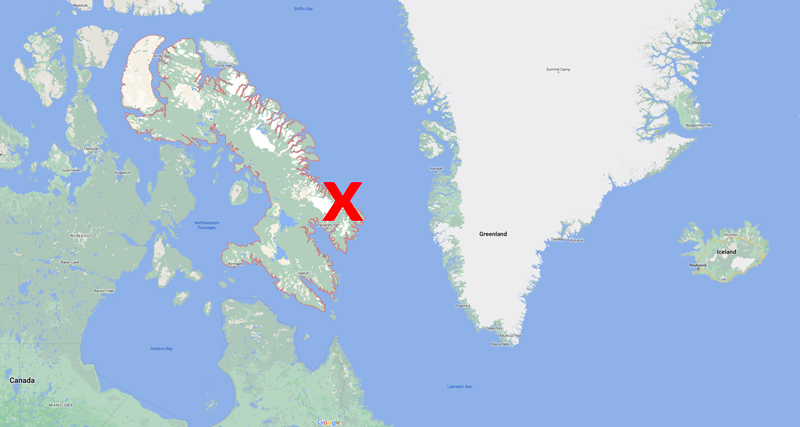
Baffin Island. X marks the spot where I spent two weeks on the sea ice.
Baffin Island is the world’s fifth-largest island and part of the Canadian territory of Nunavut. It’s larger than all but two US states, but the population density is only 0.03/km2. Not surprisingly, the living conditions on Baffin are challenging, to say the least.
Canada is home to over 60% of the world’s polar bears, and Baffin can be considered polar bear central. It includes more subpopulations than any other place on Earth. Of the 19 subpopulations, 5 of them are within Baffin Island.
April is the time that polar bear mums and their newborn cubs emerge from their dens during a period of just four weeks. That creates a very small window of opportunity to find and photograph them. But this trip was not only about finding polar bears with cubs — the spectacular mountainous landscape of Baffin is littered with giant icebergs frozen in the sea ice and makes for great landscape photography.
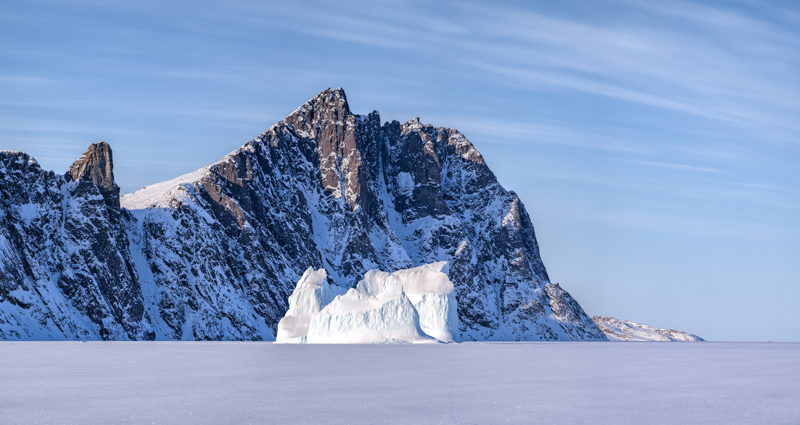
Nikon Z8 with Nikkor Z 70-200/2.8 VR S; 1/800 @ f/8.0, 165mm, ISO 64. ©Marsel van Oosten
First impressions
Even though the concept behind the Z8 is different from the Z7 and the Z9 and is positioned accordingly, I will compare the three because it will be easier to understand what the Z8 is all about.
My first impression of the Z8 was that it felt like a more compact and lightweight version of my D850. I have always praised Nikon’s ergonomics; the Z8 does not disappoint. The grip feels great in my hand. I love my Z7, but I very much prefer the beefier grip on the Z8.
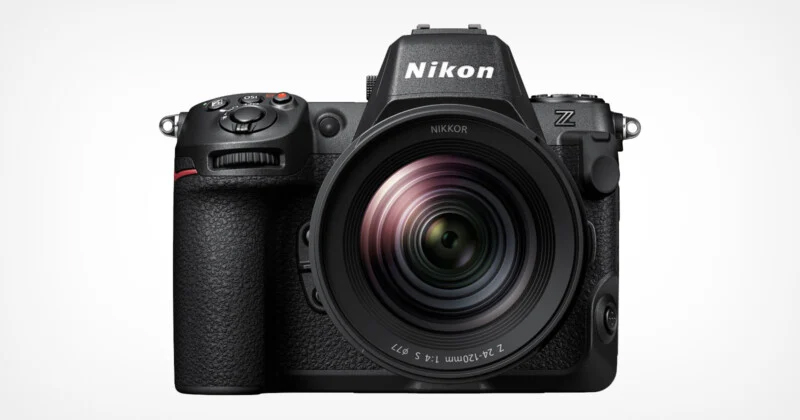
The new Nikon Z8 looks like a Nikon Z8.
On the Z7, with my index finger on the shutter button, I can barely fit three fingers around the grip. On the Z8, there is a bit more space for those three fingers, which makes the camera feel more balanced in my hand. Nothing beats the Z9 in terms of balance and grip, but considering the much more compact size of the Z8, it feels really good. While shooting in extremely cold conditions, I realized this extra grip makes a big difference when handling your camera with gloves. The Z7 was more difficult to grab and operate with gloves.
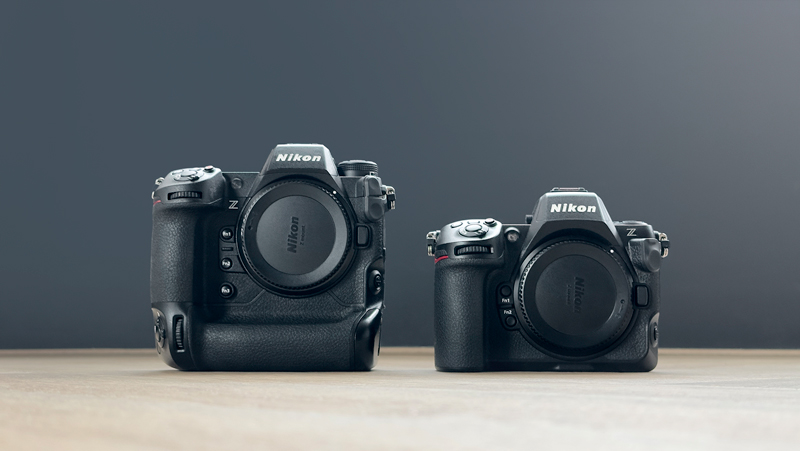
Left: Nikon Z9. Right: Nikon Z8. ©Marsel van Oosten
On the outside
But never mind the front of the camera; the back is way more important. I was happy to see that everything looked very familiar there. There is no difference with the Z7, just more space between the various buttons. That said, while the physical location of the buttons is the same, the two buttons have different functions now. The image review button on the Z7 has moved to the opposite side on the Z8 — from the upper left to the lower right, the same as on the Z9. This makes so much more sense.
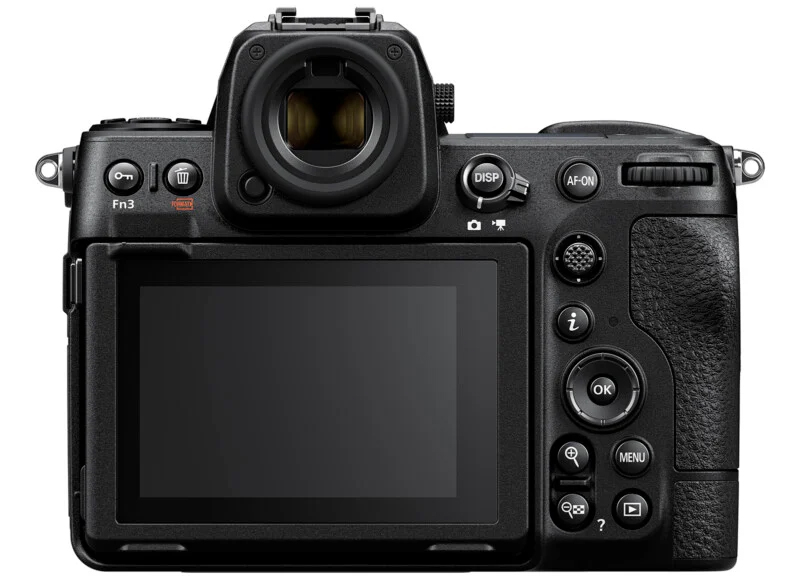
Same button placement as the Z9, just fewer of them.
The button in the upper left corner is now called Fn3 (Fn4 on a Z9). Compared to the Z9, button placement is identical. The Z9 is a much larger camera, so it has an extra row of buttons below the LCD screen and an extra wheel, joystick, and AF-ON button for using the vertical grip. Many of the buttons on the Z8 are customizable, which I find very useful. I have, for instance, moved the image review button to Fn1 on the front, where I can access it even easier and faster without moving my thumb away from the AF-ON button.
Luckily, the Z8 has the same eyepiece as the Z9, not the one from the Z7 — I have ripped a few of those trying to stuff the Z7 in my camera bag. The viewfinder housing seems a bit taller than the one on the Z9, but that might be an optical illusion.
The access door to the cards is a bit different. I have never liked the one on the Z9 as I find it difficult to slide the recessed button down and then toward you. Shooting in hot conditions with sweaty hands makes this even more challenging. I find the Z8 door much easier to open.
Once opened, there is space for two cards: one SD and one CFexpress type B. I would have loved two CF slots, but alas.
The Z8 has an articulating screen like its bigger brother, which I find especially useful when shooting from ground level.
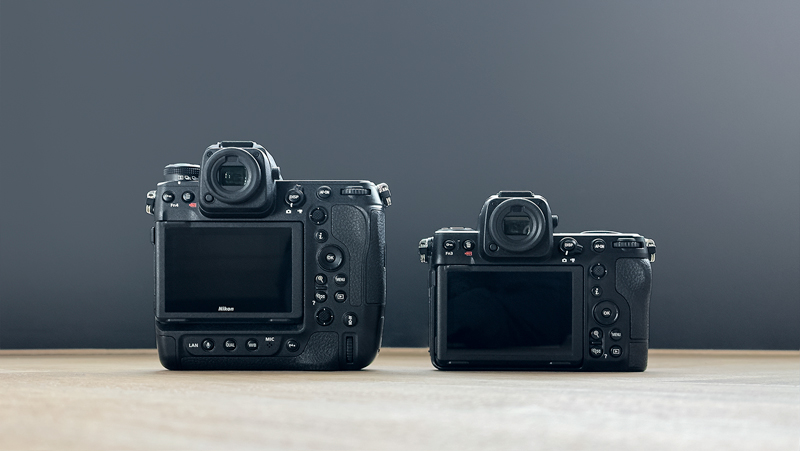
Left: Nikon Z9. Right: Nikon Z8. Same look & feel, but smaller. ©Marsel van Oosten
The size difference between the Z8 and the Z9 is significant. The Z8 is a lot smaller and lighter, mostly because of the integrated grip of the Z9. For wildlife photography and large telephoto lenses, I adore my Z9. It is super well-balanced, and the integrated grip is a necessity. However, when using medium telephoto and wide-angle lenses, it is much nicer to use a smaller body. The Z8 is easier to handhold for a long time, takes up less space in my camera bag, and has less weight to lug around.
I always travel with three bodies with lenses attached. Until now, I used 2 Z9s and a Z7. I will now replace the Z7 with the Z8. Even though the Z8 is larger than the Z7, I can still fit my standard wildlife kit in my Gura Gear Kiboko camera bag; one Z9 with Nikkor Z 400/2.8 TC VR S on one side and one Z9 with Nikkor Z 70-200/2.8 VR S and Z8 with Z24-70/4.0 S on the other. The bag’s design gives me super easy access to the gear, and having the bodies and lenses assembled saves me precious time and dust bunnies. While the sensor shield works well, dust accumulated on it will eventually end up on the sensor.
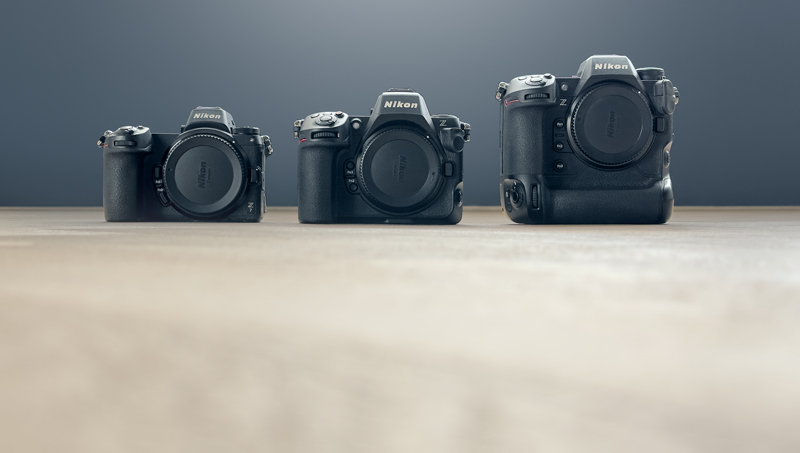
From left to right: Nikon Z7, Nikon Z8, Nikon Z9. ©Marsel van Oosten
The battery grip
Nikon has designed an optional battery grip for the Z8: the MB-N12. This means you can keep the body compact and lightweight or turn it into an almost Z9. This flexibility is great because I will use the Z8 as my primary landscape photography camera or my third wildlife photography camera with an attached Nikkor Z 24-70/4.0. I don’t need the grip for landscape photography to enjoy a more compact and lightweight camera.
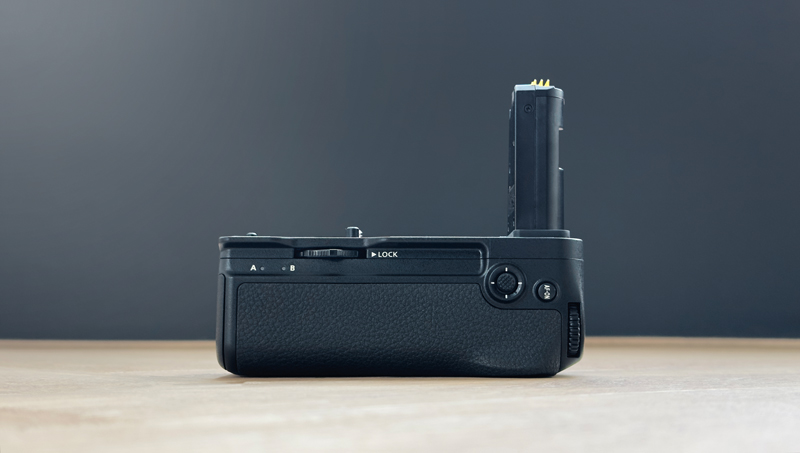
The MB-N12 battery grip for the Nikon Z8. ©Marsel van Oosten
The grip design differs greatly from all the other Nikon grips I have used. Instead of having a small electrical connector, it now has a large battery-sized protrusion sticking out from the top. To use the grip, you must first take the EN-EL15c battery out and remove the door. You can store the door in a dedicated opening in the grip. You can then insert the battery-shaped part into the battery chamber and use the screw to connect the grip to the body. I am not too excited about this design for a couple of reasons.
I hoped the grip would be like the one for the D850. On that body, you can keep the EN-EL15 battery in the camera when you add the grip. That grip can hold a powerful EN-EL18 battery, which, in combination with the EN-EL15, provides a ton of battery power. I have managed to shoot 12-hour night time-lapses like that.
The MB-N12 only holds two EN-EL15c batteries, which provide around 1.8x longer battery life than the single in-camera battery. The grip features a USB-C port for connecting to an external power source if you need more. A cool feature is that one of the batteries can be hot-swapped for on-the-fly battery switching. Also, batteries can be charged inside the grip even when not attached to the camera.
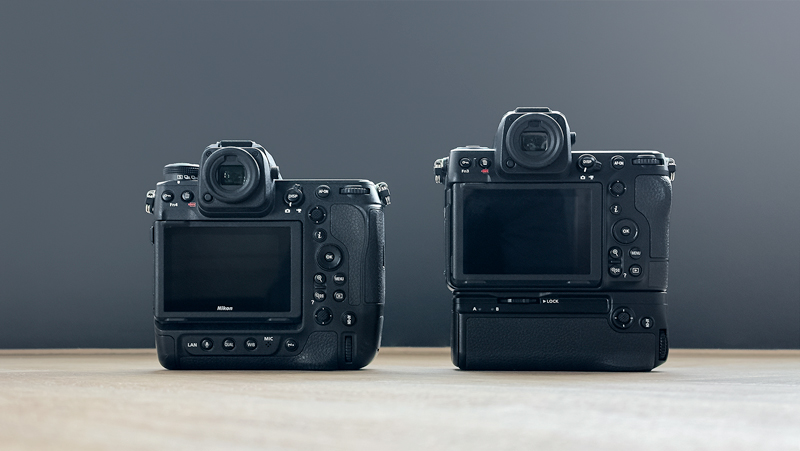
Left: Nikon Z9. Right: Nikon Z8 with battery grip. ©Marsel van Oosten
Adding the grip to the Z8 significantly increases the size of the camera. I could only barely close the zipper of my camera bag when I added the grip to my Z8 with a lens attached. Also, the ergonomics are quite different compared to the Z9’s vertical grip. On the Z9, your thumb is close enough to all four buttons next to the multi-selector. Using the MB-N12 takes some finger gymnastics to operate those buttons while shooting verticals.
At some stage, my MB-N12 stopped working. I figured it was either because it was a prototype or too cold, so I removed it. The next day, I charged the batteries and tried again. That’s when I got an error message on the screen warning me that I should only use original Nikon batteries. I have a lot of third-party EN-EL15 clones because they’re cheaper, and this is the first time I’ve had this happen. After I swapped them for the real deal, the grip worked again. Not sure if this is simply a prototype glitch or if the grip will only take the original batteries.
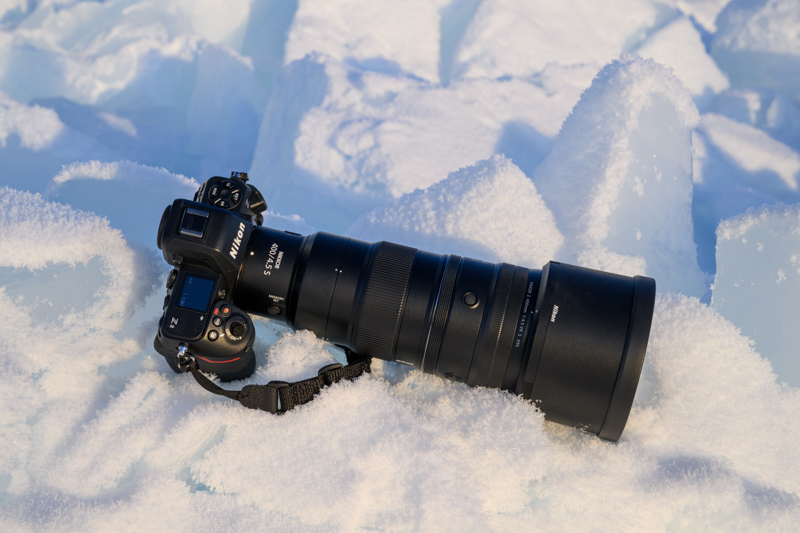
The Z8 has the same dust- and drip-resistance performance as the D850. ©Marsel van Oosten
In the field
The two biggest challenges on this trip were finding the bears and dealing with the harsh conditions. Life in the high Arctic can be brutal for humans and camera gear, so I knew it would not be a walk in the park. Dressing for the cold is fairly straightforward, but incredibly important to do it right. For photographers, the hands are always the greatest challenge. It’s easy to keep your hands warm but to photograph, you must take off your super warm mittens and operate the camera with liner gloves. Holding a camera at –30C is like holding a chunk of ice — your hands get very cold very quickly, especially your shutter finger. I used special photographic mittens by The Heat Company that helped, and I added little felt tips to the shutter buttons — to make them less cold to the touch and to make them easier to find wearing gloves.
I also put LensCoat neoprene covers on all my lenses for added comfort and safety: at -30C, you don’t want any bare skin to touch the metal lens.
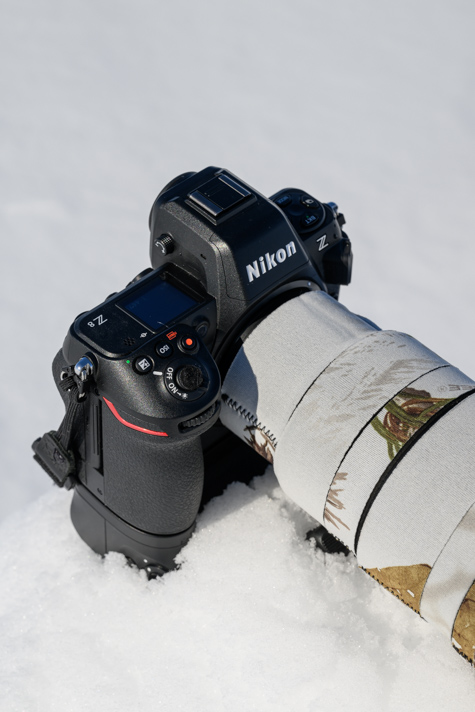
Neoprene covers are not for camouflage but for keeping my hands and fingers warmer.
Overall, all the camera gear performed really well in the cold. We spent, on average, 9 hours outside each day, and I never had any issues. The Z8 performed flawlessly except for one little thing: changing cards requires you to push the card in so that the internal spring pushes it out again. On the coldest days, I noticed the cards came out very slowly or only a bit. I sometimes had to use my nails to pull them out. Again, I don’t know if this is simply a prototype glitch.
Battery life
On this trip, I used two Z9s and the Z8. The EN-EL18d battery in the Z9 is superb in extreme cold. A fully charged EN-EL18d lasted me a full day. The EN-EL15c is much more affected by the cold. Not only while shooting but also when it was just sitting in the camera inside my bag. This was an extra reason to use the grip and have two batteries instead of one.
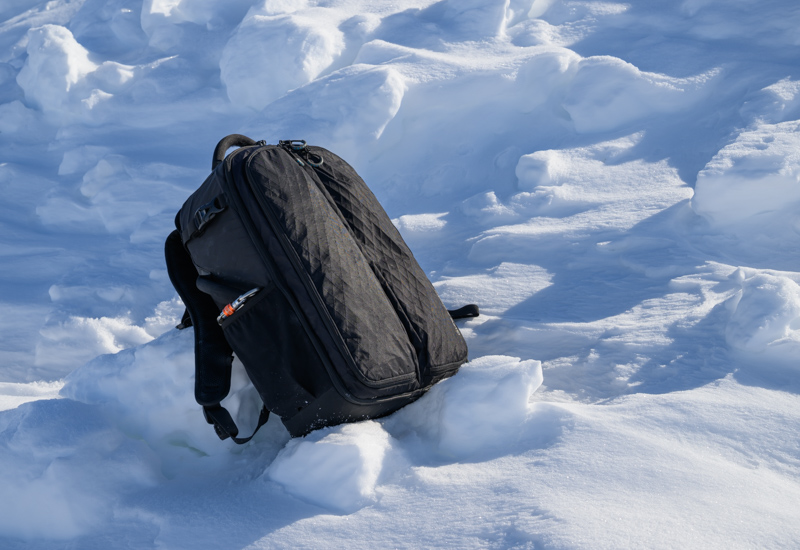
My Gura Gear Kiboko bag stayed outside in the freezing cold for two weeks. ©Marsel van Oosten
I should add that during the entire trip, I always kept my camera bag outside. Inside our tent, it got too warm or too humid, and I didn’t want to risk causing any condensation inside my gear. I only took the cards and batteries inside. The Z8 minimum operating temperature is rated -10C, but it can clearly handle a lot more cold than that. Note that the Sony ⍺7RV and the Canon R5 minimum operating temperature are rated at 0C.
On the inside
The Z8 menu is the same as the Z9, so no surprises there. That said, there are some differences between the two cameras. Here are some things the Z8 can do but the Z9 cannot:
• The Z8 can shoot 10-bit HEIF images
• The Z8 has a portrait impression balance and a skin softening settings
• The Z8 has a USB terminal dedicated to communication (but no LAN or Synchro terminal)
• Vertical playback in vertical orientation
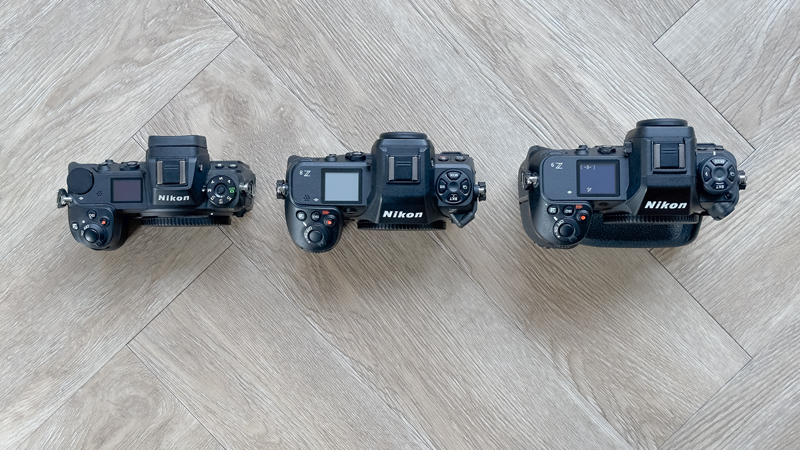
From left to right: Nikon Z7, Nikon Z8, Nikon Z9. ©Marsel van Oosten
And here are some things that Z9 can do but the Z8 cannot:
• Continuous video recording time in 8K/30p is 125 min vs 90 min for the Z8
• 700 shots on a single battery vs 330 for the Z8
• Voice memo microphone
• Integrated vertical grip
If you’re like me, you will look at those differences and say: that’s it? Yep, that’s it. I may be unaware of one or two others, but I doubt they will be significant. Based on the specs alone, the Z8 is, therefore, literally a mini Z9. Smaller, lighter, cheaper, but just as powerful. That sounds too good to be true, so I wondered how the Z8 would perform in the field.
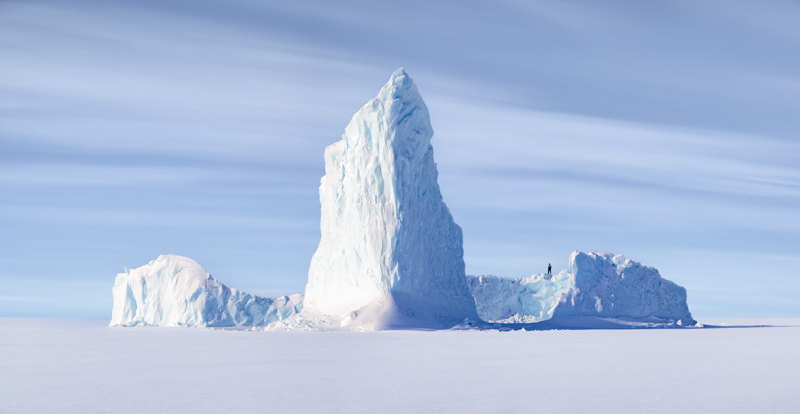
12-Image panorama. Nikon Z8, Z70-200/2.8 VR S, 1/500 @ f/8.0, ISO 64. ©Marsel van Oosten
Handling
I really enjoyed the Z8 for handheld shots with the Z 70-200/2.8 VR S and the Z 400/4/5 VR S lenses. Those lenses are almost the same size and, coupled with the Z8, made for a very balanced setup. Although our primary focus was polar bears, we spent considerable time shooting distant landscapes and icebergs. For the image above, I asked our guide Cyle to climb the iceberg to add a sense of scale and adventure. I wanted to stay quite a distance away to get a more pleasing perspective, and the 70-200 was perfect for that. Instead of taking a single horizontal frame, I decided to compress the perspective even more, zoom in to 165mm, and shoot 12 vertical images to create this panorama.
On this trip, I saw a lot of bears. As we tried to stay 100m away from any bear, I shot most bear images with my Z9 and Z 600/4.0 TC VR S lens. However, every now and then, a bear decided to check us out or walk right by us — too close for the 600. For those dynamic moments, I always had the Z8 with the super lightweight 400 prime close to me. Easy to pick up with one hand and easy to handhold and follow the action. The image below is from one of those moments.
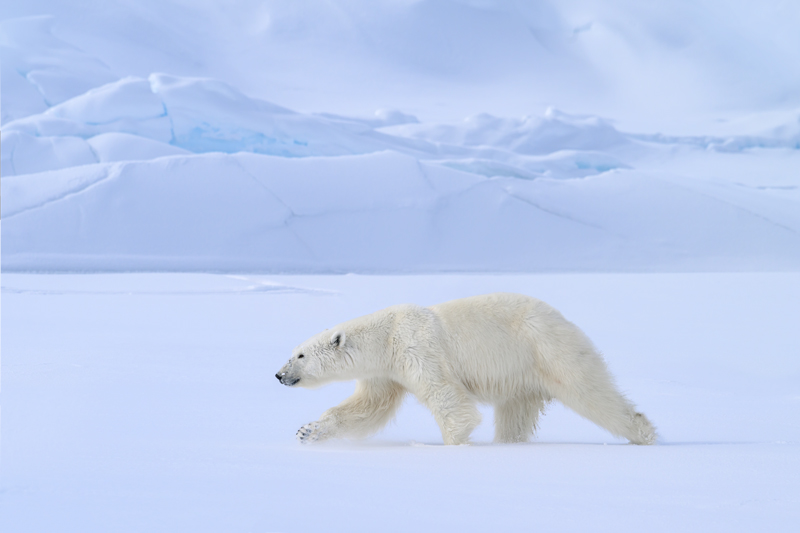
Nikon Z8 with Nikkor Z 400/4/5 VR S, 1/2500 @ f/9.0, ISO 500, handheld.
Sensor
The Z8 has the same dual coating sensor as the Z9: 45,7MP (stacked), protected with a sensor shield. The ISO sensitivity range is also identical: 64-25,600 expandable on both extremes. The dynamic range of the Z8 is very impressive. In high-contrast situations, like shooting an approaching skidoo in the snow, I would just meter for the highlights and make sure they don’t blow out while ignoring the blacks —knowing that I can very easily recover those dark areas without introducing any noise.
Many cameras today are close to ISO-invariant, which means that increasing ISO in-camera provides a similar level of image quality as brightening the photo in post-processing. The Nikon Z8 and Z9 are not fully ISO-invariant cameras. Instead, they have dual gain sensors that switch at ISO 500. That means everything from ISO 64 through 400 could be accurately simulated by brightening ISO 64, and everything from ISO 500 onward could be accurately simulated by brightening ISO 500. Therefore, ISO 500 will give a better result than ISO 200 regarding noise, and ISO 1,600 will show less noise than ISO 400. For more info on this phenomenon, check out this link. If you want to keep things simple, avoid overexposure in the highlights, especially above ISO 500.
I have not specifically tested the high ISO performance of the Z8, but I have shot very usable images with my Z9 at ISO 25,600, so the Z8 will be no different. It has an AF detection range from -7 EV to 19 EV, dropping to -9 EV using the Starlight View setting.
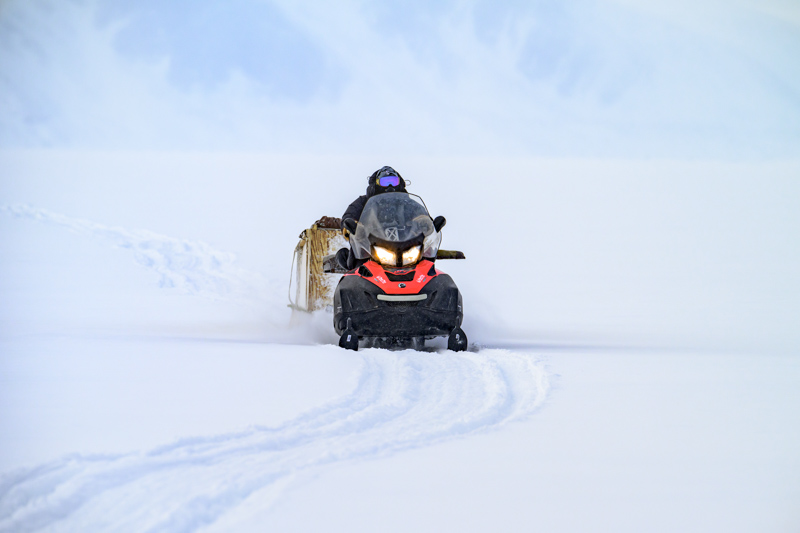
Nikon Z8 with Z 400/4.4 VR S. 1/2000 @ f/7.1, ISO 500. ©Marsel van Oosten
Autofocus performance
At the risk of getting repetitive, the Z8 has the same image-processing engine and autofocus capabilities as the Z9. The only difference I saw was the Dedicated Airplane subject detection setting, whatever that is. I don’t shoot airplanes, but I’m sure the plane spotters will be excited. Of the wide range of AF modes to choose from, I typically use Pinpoint for landscape photography and very static wildlife, Dynamic Area S for things that are moving predictably, and 3D-tracking for serious action and/or when I want to keep my subject in a very specific spot in my frame. The 3D-tracking worked perfectly on the skidoos, but polar bears being quite light against a bright background was sometimes tricky in sunny or heavily backlit conditions. If the one AF mode doesn’t give me the results I’m after, I quickly switch to another by pressing a customized button and rotating a dial. It takes less than a second. With so many AF modes, I recommend you try them all in various conditions to learn to pick the right one when it matters most.
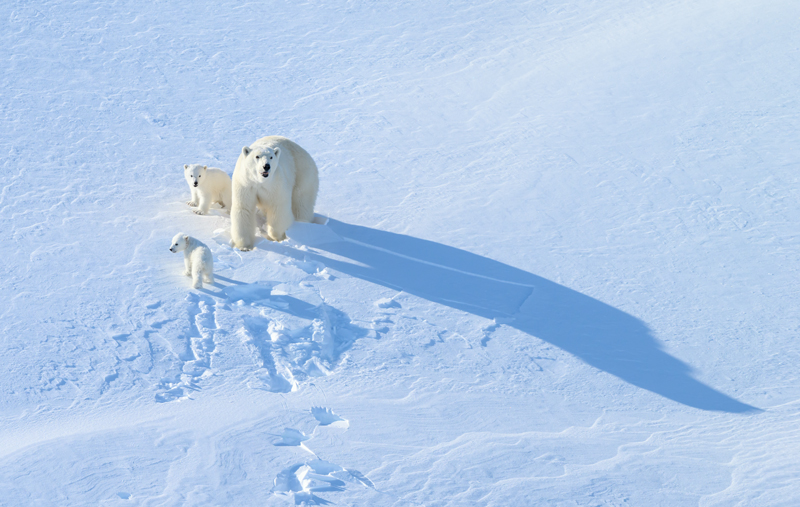
Nikon Z8 with Z 600/4.0 TC VR S @ 600mm. 1/2500 @ f/9.0, ISO 500. ©Marsel van Oosten
The new Nikkor Z 600/4.0 TC VR S with a built-in teleconverter is an amazing lens. Weighing only 3260 g (7 lb 3 oz), it is almost 6oo g lighter than the F-mount version and even lighter than the AF-S VR 180-400/4.0 TC. Coupled with the Z8, that makes it not completely insane to shoot handheld. The image above was a fleeting moment — a female polar bear and her two spring cubs were walking up a mountain slope and briefly stopped to check us out. Looking at their body language, we decided to stay at a fair distance, especially considering the smallest cub looked underweight. I got this shot by shooting the Z8 with the 600 handheld, as there was no time to set up my tripod. Autofocus was swift and accurate.
The only times I struggled to focus was when there were a lot of ice crystals in the air. The Z8 and the Z9 struggled to autofocus in those conditions, especially with the long telephoto lenses. This turned out to be non-camera specific — even my iPhone was unable to focus. It’s comparable to trying to autofocus in heavy snow or rain.
I almost forgot to mention the Pre-capture function: when selected, the Z8 maintains an image buffer before pushing the shutter release. It records the buffer when the shutter button is pressed. This is extremely useful when waiting for a bird to take off or anything else that requires perfect timing.
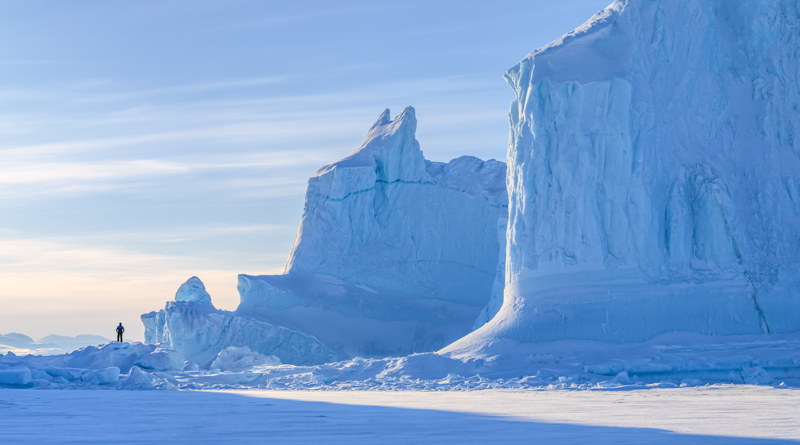
4-Image panorama, Nikon Z8 with Z 70-200/2.8 VR S @ 70mm, 1/250 @ f/11, ISO 64, handheld. ©Marsel van Oosten
Image quality
The image quality is superb. I have already been shooting with two Z9s for over a year now, and the images from the Z8 are identical. This is one of the reasons why I will replace my Z7 with the Z8. My Z9s are my primary (wildlife) bodies, and I always travel with a third body because I prefer not to change lenses in the field — for dust and for speed reasons. The Z7 is a much slower camera, but the images also have a different look to them, and I obviously prefer to have similar-looking images from the same scene.
Video
You will hear people call the Z8 a hybrid camera because it is a photographic powerhouse and a very serious video camera. Being a photographer, I didn’t shoot much video. Whenever something cool happened, I wanted to take photographs, not videos. I did, however, shoot various clips at various settings, and the results look really good. The high-quality codecs require color grading in video editing software which I have not done yet, but I shot a short test clip to see how the sensor would pick up all the subtle colors and hues after sunset.
Conclusion
The conclusion is a predictable one: the Nikon Z8 is a mini Z9. It is virtually the same as the Nikon flagship camera, only smaller, lighter, and cheaper. Surprisingly, the biggest differences are on the outside. On the inside, where it matters most, things are virtually the same. Even the maximum frame rate is exactly the same. If you wanted a Z9 but couldn’t afford one or thought it was too big, the Z8 will be the perfect alternative. Well balanced, as powerful as its bigger brother, but in a smaller package. My only negatives are the design and batteries of the optional grip, and the fact that there is no space for two CFexpress cards. Other than that, it’s near perfect. The waiting list is going to be very long.
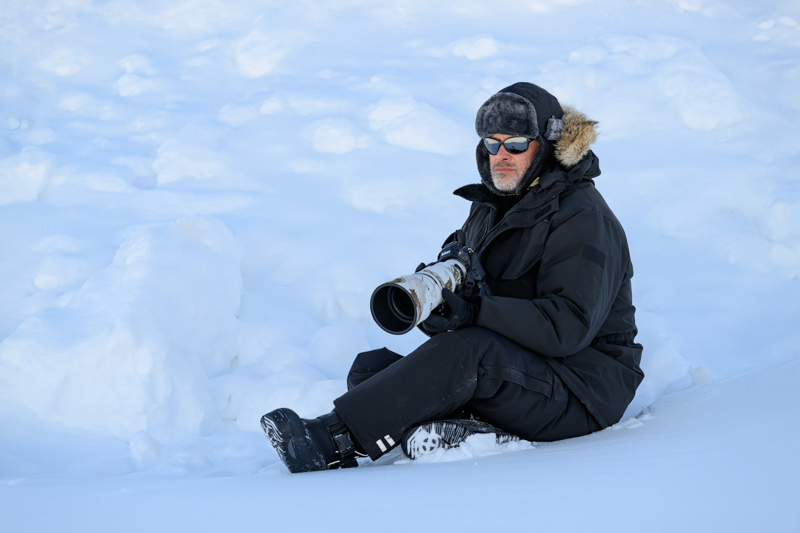
The author with the Nikon Z8 and Nikkor Z 400/4.5 VR S. ©Daniella Sibbing
About the author
Marsel van Oosten is a professional nature photographer and death metal connoisseur from The Netherlands. He is the world’s only photographer to have won the Grand Slam: the grand titles Wildlife Photographer of the Year, International Nature Photographer of the Year, and Travel Photographer of the Year. His latest book is called MOTHER — A Tribute to Mother Earth.
Marsel currently lives in South Africa with producer Daniella Sibbing. Together they run specialized nature photography tours for small groups of all experience levels to worldwide destinations. An overview of Marsel’s work can be found on his website.







